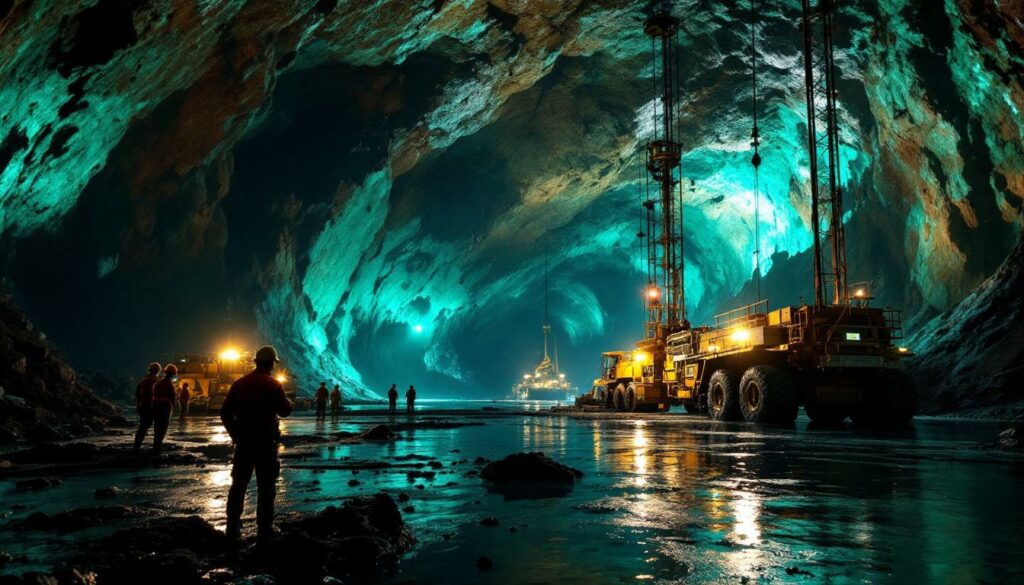What Happened at Ivanhoe Mines' Kamoa-Kakula Complex?
The Seismic Event and Its Immediate Impact
On May 20, 2025, the Kamoa-Kakula copper complex in the Democratic Republic of Congo experienced a significant seismic event that dramatically altered operations at one of the world's premier copper sites. The incident affected approximately 30% of the Kakula mine resource, with the eastern section bearing the brunt of the damage. This forced Ivanhoe Mines to immediately suspend operations at what is considered the fourth largest copper discovery in history.
"The seismic event was unprecedented in the mine's operational history," explained CEO Marna Cloete at the London Indaba mining investment conference. "Infrastructure damage was so severe that we had to make the difficult decision to let the eastern side of the mine flood as the side walls kept collapsing."
Production Consequences and Revised Guidance
Following the incident, Ivanhoe Mines dramatically reduced its 2025 copper price prediction guidance by 28%, adjusting expectations from 520,000-580,000 tonnes to 370,000-420,000 tonnes of copper in concentrates. This represents a reduction of approximately 150,000 tonnes from the global copper supply, creating potential ripple effects throughout the market.
The company's share price experienced immediate volatility following the announcement, reflecting investor concerns about both short-term production capabilities and longer-term operational stability at the flagship project.
"This is a significant but temporary setback for what remains one of the world's most promising copper assets," noted Cloete. "While we've had to revise our immediate expectations, the fundamental value of Kamoa-Kakula remains unchanged."
Why Did the Seismic Event Occur?
Technical Failures in Mining Methodology
At the heart of the incident was a fundamental miscalculation in the mine's backfill methodology. According to Cloete's candid assessment, the company "probably miscalculated" critical assumptions about how backfill material would behave and its ability to effectively replace supporting pillars in the mine structure.
"When mining a deposit of this scale and characteristics, theoretical models don't always perfectly predict real-world behavior," Cloete explained. "Our assumptions about how backfill would behave—and the fact that it replaced pillars—were probably miscalculated."
This technical failure had catastrophic consequences, as the backfill material failed to provide adequate structural support, ultimately contributing to the seismic event that damaged critical infrastructure throughout the eastern section of the mine.
Geological Uniqueness and Challenges
The Kamoa-Kakula deposit presents exceptional challenges due to its distinctive geological characteristics. Unlike many copper deposits that have been developed in recent decades, this one features a "shallow, thick ore body" that requires specialized mining approaches.
"There haven't been many discoveries like Kamoa-Kakula in the past couple of years," Cloete emphasized, highlighting how the exceptional nature of the deposit contributed to the technical miscalculations. "When you're working with a truly world-class, unique deposit, there's limited precedent to draw upon."
Mining engineers had to develop methodologies specific to this unusual formation, and the seismic event has revealed critical flaws in those approaches that now require comprehensive revision.
How Is Ivanhoe Addressing the Crisis?
Emergency Response and Flooding Management
In the immediate aftermath of the seismic event, Ivanhoe faced a critical decision regarding the damaged eastern section of the Kakula mine. With infrastructure severely compromised and water rapidly accumulating, the company made the difficult but necessary choice to allow controlled flooding of the eastern section.
"We had to take a decision to let the eastern side of the mine flood," Cloete explained. The damage was so extensive that electricity supply to crucial dewatering pumps was compromised, as the pumps were connected to side walls "that basically just kept falling off," making immediate dewatering impossible.
This controlled flooding approach prevented further structural damage while allowing the company to focus resources on stabilizing the western section and developing a comprehensive recovery plan.
Current Dewatering Efforts
Ivanhoe is now implementing an aggressive dewatering strategy to recover the flooded eastern section of the mine. The company is managing substantial underground water inflows of approximately 4,000 liters per second using temporary underground pumps with a capacity of about 4,400 liters per second.
Additionally, the company has ordered four high-capacity surface pumps, each with 650 liters per second capacity (totaling 2,600 liters per second), to be installed via shafts later in 2025. This combined pumping capacity of over 7,000 liters per second should provide sufficient redundancy to handle the significant water challenges.
"Our Chinese partner Zijin, alongside CITIC Metal, has been instrumental in swiftly procuring additional dewatering equipment," Cloete noted, highlighting the value of strong international partnerships in crisis response. With this comprehensive approach, the company expects to have the eastern side of the mine fully dewatered by the end of 2025.
What Are the Long-Term Implications for Mining Operations?
Complete Mining Methodology Overhaul
The technical issues exposed by the seismic event have forced Ivanhoe to fundamentally rethink its mining approach across the entire Kamoa-Kakula complex. This represents perhaps the most significant operational change in the project's history.
"Going forward, we will mine based more on a geological understanding of what's ahead of us, leaving much larger pillars, and then also mining out to the periphery and then retreat mining back," Cloete explained. This represents a significant shift from the company's previous methodology, prioritizing long-term stability over short-term production maximization.
The new approach will incorporate:
- Larger support pillars throughout mining areas
- Peripheral-to-core extraction sequencing
- Retreat mining techniques
- Enhanced geological monitoring systems
- More conservative backfill assumptions
These changes reflect a more cautious operational philosophy that prioritizes long-term asset preservation over immediate production targets.
District-Wide Implementation of New Techniques
The revised mining methodology won't be limited to the Kakula mine but will extend to the entire complex. "We will also go and do the same at Kansoko and the same at Kamoa," Cloete confirmed, referring to other mines within what she described as "a massive mining district."
This comprehensive approach demonstrates Ivanhoe's commitment to applying lessons learned across all operations, even those not directly affected by the seismic event. By standardizing these enhanced safety protocols throughout the district, the company aims to prevent similar incidents at any of its mining operations.
The district-wide implementation will require significant retraining of personnel, equipment modifications, and potential timeline adjustments for development milestones, but represents a necessary investment in the long-term viability of the entire Kamoa-Kakula complex.
How Is Production Being Maintained During Recovery?
Western Operations and Surface Stockpiles
While the eastern section of Kakula remains flooded, Ivanhoe has implemented a multi-faceted strategy to maintain production levels. The company restarted mining on the western side of the mine on June 7, 2025, after successfully stabilizing underground water levels and confirming structural integrity.
"We've been fortunate that the western section remained largely unaffected by the seismic event," Cloete noted. "This has allowed us to resume operations in that area while we address the challenges in the east."
In addition to western mining operations, the company is strategically utilizing surface stockpiles that had been accumulated as part of normal operations. "We luckily have stockpiles on surface that we're currently milling," Cloete explained, providing a critical buffer that has helped maintain concentrate production during the recovery period.
Workforce Redeployment
To maximize production during the recovery period, Ivanhoe has strategically redistributed its workforce across the mining complex. Rather than furloughing workers from the affected eastern section, the company has found productive roles for them elsewhere.
"We've moved some of our crews to our other mining areas where there's scope to increase and open up new mining faces," Cloete explained. This approach serves multiple purposes:
- Maintains employment for the workforce
- Accelerates development in unaffected areas
- Creates additional production capacity
- Preserves skilled labor within the company
- Demonstrates commitment to local communities
This flexible workforce management strategy demonstrates Ivanhoe's adaptability in crisis management and commitment to maintaining operational continuity despite significant challenges.
What Progress Is Being Made on Other Fronts?
Smelter Commissioning Timeline
Despite the operational challenges at Kakula, Ivanhoe continues to make progress on other critical infrastructure projects. The company expects to commission its blister copper smelter in early September 2025, with "first anode expected in October."
The smelter represents a major strategic asset for Ivanhoe, designed to operate at an initial capacity of approximately 250,000 tonnes per year. Once operational, it is expected to "reduce our logistic charges by about 50%," according to Cloete, providing significant financial benefits during the recovery period.
This vertical integration will allow Ivanhoe to process more of its concentrate on-site, reducing reliance on third-party smelters and cutting transportation costs—a particularly valuable advantage during a period of reduced production.
Applying Lessons to Other Projects
The company is proactively applying insights from the Kakula incident to its other mining operations, demonstrating a commitment to organizational learning and risk management.
"We've already started applying the same lessons to Platreef [in South Africa], the same lessons to Kipushi, getting people with fresh eyes to look at what we've done, what our designs are, so that we do not repeat the same mistake," Cloete emphasized.
This cross-project learning extends to the recently developed Kipushi zinc-copper-germanium-silver-lead mine, also in the DRC, which completed its 800,000-tonne-per-year concentrator in May 2024, with first production of concentrate achieved the following month.
By implementing these preventative measures across all assets, Ivanhoe aims to create a more resilient operational portfolio that can withstand geological and technical challenges.
What Does This Mean for Copper Supply and Markets?
Impact on Global Copper Production
The significant reduction in production guidance from one of the world's newest and largest copper mines will likely have ripple effects throughout global copper markets. With a reduction of approximately 150,000 tonnes from original projections, this disruption represents a meaningful impact on anticipated global copper supply for 2025.
In the context of a market already facing potential supply constraints as electrification drives demand growth, this production shortfall could contribute to tighter market conditions and potential price support in the near term. The timing is particularly significant as it coincides with growing copper demand for renewable energy infrastructure and electric vehicles.
Market analysts will be closely monitoring how quickly Ivanhoe can restore full production capacity, as prolonged disruption could have more substantial implications for global copper investment insight balance sheets in 2025 and beyond.
Long-Term Outlook for Kamoa-Kakula
Despite the current challenges, Cloete remains optimistic about the long-term prospects of the complex. "I'm bullish on Kamoa-Kakula. If you look at just what it is in the great scheme of things, it's the fourth largest copper discovery ever," she stated.
The fundamental asset quality remains unchanged, with exceptional ore grades and significant unexplored potential still defining the project's long-term value proposition. While the seismic event has necessitated operational adjustments, it doesn't diminish the extraordinary geological endowment that makes Kamoa-Kakula a generational mining asset.
"It's just one of those mining complexes that will stand the test of time. This would be one chapter in a very thick book," Cloete added, emphasizing the company's long-term perspective on the asset despite current operational challenges.
The revised mining methodology, while potentially reducing near-term production rates, may ultimately enhance the long-term sustainability and safety of operations, potentially extending the productive life of the mines.
FAQ: Kamoa-Kakula Seismic Event and Recovery
What percentage of the Kakula resource was affected by the seismic event?
The seismic event affected approximately 30% of the Kakula resource, with 20% of that in the eastern zone that subsequently flooded. However, Cloete expressed optimism that "the experts reckon we will be able to recover a good portion of that once we get through" the dewatering and stabilization process.
This suggests that while a significant portion of the resource was initially impacted, the company expects to recover access to most of the affected areas over time, limiting the long-term resource impact of the incident.
How does this incident affect Ivanhoe's position in the copper market?
While the production setback is significant in the short term, the Kamoa-Kakula complex remains one of the world's premier copper assets. The incident may delay Ivanhoe's growth trajectory but doesn't fundamentally alter the exceptional quality and scale of the resource.
In the broader market context, Ivanhoe still controls one of the most significant new copper developments in decades, with substantial expansion potential beyond current operations. The company's long-term contribution to global copper supply remains largely intact, though near-term projections have been reduced.
What role did Ivanhoe's partners play in the response?
Cloete specifically credited Chinese partner Zijin (alongside CITIC Metal) for swiftly procuring additional dewatering equipment, highlighting the value of strong partnerships in crisis response.
This international collaboration has been crucial in sourcing specialized equipment on short notice, demonstrating the strategic importance of Ivanhoe's joint venture structure in managing operational challenges. The diversified expertise and resource access provided by these partnerships has accelerated the recovery process.
How does this incident compare to other mining disasters?
Unlike many mining incidents that result in casualties or environmental damage, this event appears to be primarily a technical and operational challenge. Cloete characterized it not as a "failure" but rather as "a temporary glitch" and "a lesson for us."
The controlled nature of the response, including the decision to allow flooding rather than risking unstable conditions, reflects a prioritization of safety over production. While economically significant, the incident has not resulted in reported injuries or external environmental impacts, distinguishing it from more severe mining disasters.
What is the status of Ivanhoe's other projects?
The Kipushi zinc-copper-germanium-silver-lead mine in the DRC recently completed its 800,000-tonne-per-year concentrator in May 2024, with first production of concentrate achieved the following month, demonstrating that Ivanhoe continues to make progress on other fronts despite the challenges at Kakula.
This diversification across multiple projects provides Ivanhoe with operational and financial flexibility during the Kakula recovery period. The company's portfolio approach helps mitigate the impact of disruption at any single operation.
Further Insights on Copper Mining Challenges
Geological Complexity in Modern Copper Deposits
The Kamoa-Kakula incident highlights a growing challenge in the copper mining industry: as the most accessible deposits become depleted, companies are increasingly developing technically complex resources that present unique engineering challenges.
The "shallow, thick ore body" at Kamoa-Kakula represents a distinct geological formation that required innovative mining approaches—approaches that ultimately contained flaws exposed by the seismic event. This serves as a reminder that even with modern mine planning techniques, geological surprises can still dramatically impact mining operations.
Water Management as a Critical Mining Competency
The scale of water management required at Kamoa-Kakula—handling inflows of 4,000 liters per second—underscores how water management has become a defining competency for modern mining operations. The difference between operational success and failure increasingly depends on sophisticated dewatering systems and hydrogeological understanding.
Ivanhoe's deployment of pumping capacity exceeding 7,000 liters per second demonstrates the industrial-scale water management infrastructure required at major mining operations today, particularly in regions with significant groundwater challenges.
The Evolution of Mining Methodologies
Ivanhoe's shift to "retreat mining" techniques represents part of a broader industry evolution in underground mining methodologies. This approach, which involves developing to the periphery of an ore body and then mining backward toward the main access, often provides enhanced stability and safety compared to traditional methods.
The company's experience demonstrates how mining industry evolution must continuously adapt in response to operational learnings, particularly when developing world-class deposits with unique characteristics that may not fit established mining templates. Furthermore, the incident highlights the critical importance of mineral exploration importance in understanding deposit characteristics before full-scale mining begins.
Disclaimer: This article contains information about mining operations, production forecasts, and geological assessments that are subject to various risks and uncertainties. Actual results may differ materially from those projected. The information presented is based on company statements and industry analysis as of June 2025 and should not be considered investment advice. Readers should conduct their own research and consult financial advisors before making investment decisions.
Want to Catch the Next Major Mineral Discovery Before the Market?
Discovery Alert's proprietary Discovery IQ model delivers real-time notifications on significant ASX mineral discoveries, helping investors identify opportunities before the broader market. Don't miss out on the next potential Ivanhoe-scale discovery – visit https://discoveryalert.com.au/discoveries/ to see how major mineral discoveries have generated exceptional returns and begin your 30-day free trial today.




